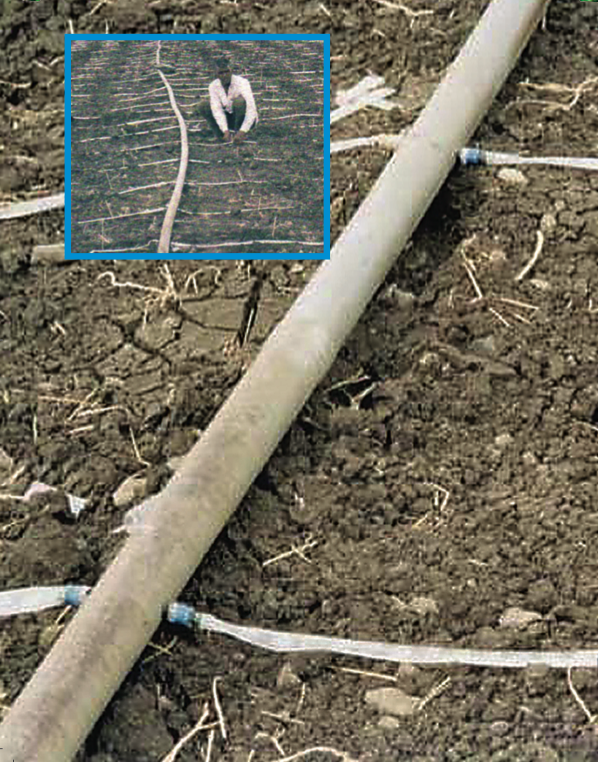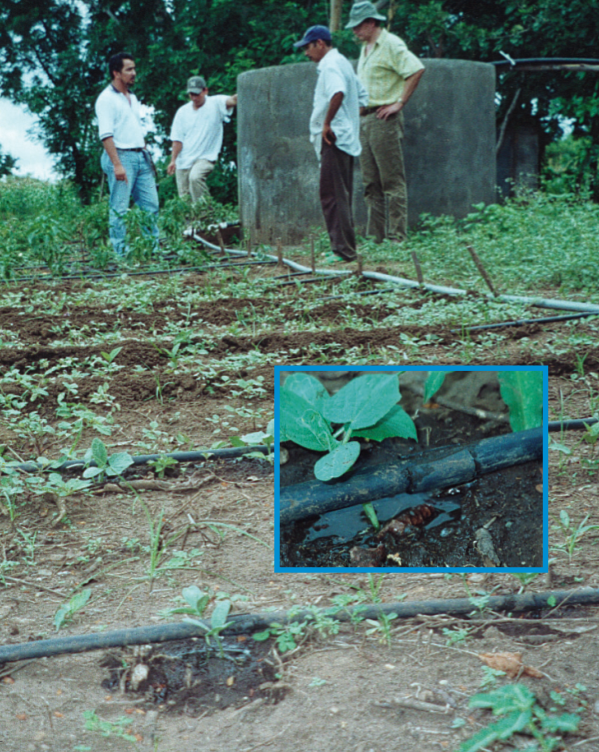Difference between revisions of "Drip Irrigation - Pepsi and Nica"
(→Suitable conditions) |
(→Acknowledgements) |
||
| Line 60: | Line 60: | ||
==Acknowledgements== | ==Acknowledgements== | ||
| + | * CARE Nederland, ''Desk Study Resilient WASH systems in drought prone areas.'' October 2010. | ||
* Sijali, Isaya V. [http://www.samsamwater.com/library.php?cat=irrigation Drip Irrigation; Options for smallholder farmers in eastern and southern Africa]. Sida’s Regional Land Management Unit, 2001. | * Sijali, Isaya V. [http://www.samsamwater.com/library.php?cat=irrigation Drip Irrigation; Options for smallholder farmers in eastern and southern Africa]. Sida’s Regional Land Management Unit, 2001. | ||
Revision as of 01:46, 14 April 2012
Drip irrigation provides farmers the most efficient way to grow crops in water scarce areas through providing water at a controlled and regular rate to the root zone. Historically it has been too expensive for small-plot farmers, but now it is available at low cost and also adapted for small-scale farming and can reduce water losses by 30 - 70% when compared to conventional methods of crop irrigation, while greatly reducing labour and accurately delivering fertilizers. This makes cultivation during the dry season possible, with resulting yield increases of up to 30%.
To make drip irrigation affordable for small farmers, the Chapin bucket or IDE bucket and drum kits were developed and are now being promoted in many countries. A bucket kit costing US$ 5 can irrigate 25 m2 and a drum kit five times as much. Based on this principle, farmers in India started to make their own drip system, made of plastic hose that is normally used to package ice-lollies. Hoses can only be used for one growing season (generating plastic waste) but investment costs are so low that it is not a risk for poor families to invest in it. This technology now more or less promotes itself.
Easy drip irrigation is an improvement of the Pepsi drip that consists of sun resistant lay-flat hoses and micro tubes that have a lifetime of 1-2 years. This option is being developed by IDE and applied in Asia. Practica foundation is testing different options in Nicaragua, Tanzania, Zambia and Ghana.
Suitable conditions
- Drip irrigation is often the favoured method of irrigation, for example on steep and undulating slopes, for porous soils, for shallow soils, fields having widely varying soils, where water is scarce, where water is expensive, and where water is of poor quality.
- Drip irrigation is suitable for any plot under 0.4 hectare (one acre), but their modular design allows for expansion above that.
- The Pepsi drip has a capacity of 0.1 - 2 ha.
| Advantages | Disadvantages/limitations |
|---|---|
| - Reduces water consumption. - Uses commonly extruded plastic pipes, so low-cost systems are replicable in many countries. |
- Hoses have a short lifetime (generating plastic waste). - Possibilities of theft. |
Construction, operations and maintenance
Use the most economical system possible that will give results. iDE in Cambodia lowered the cost of drip systems by:
- Replacing conventional emitters with holes and micro tubes.
- Shifting water distribution lines extending to crops.
- Customizing system layouts for small plots.
- Reducing cost of water storage – the use of a hanging plastic water storage bag also lowers the cost. Experience shows that costs are reduced by three quarters by doing this, resulting in cost of about US$5 for a 200 litre bag that will cover 20 m2.
- The water tank capacity should be equal to one day retention of the daily water requirement. It should be placed at sufficient height to allow flow by gravity – approximately 1 metre height for an area of 100m2, 1.5 metres for 500 m2, and 2 metres for 1,000m2.
- A filter is needed prior to water entering the pipes in order to keep them clean from clogging.
- Pipes vary in size and are made from varieties of polyethylene (PE) and soft PVC.
- The emitter is the most important part of a drip system because it delivers water at the desired rate to the plant and maintains water application uniformity over the entire irrigated area. An emitter should match particular field conditions including type of crop, spacing of the plants, terrain, water requirement, water quality, operating time and pressure head. At the same time, the emitters cause the most problems through blockages (particles, salts or algae) and need to be maintained.
- Try to bury main pipes underground to reduce visibility for theft.
Estimated Lifespan
1-2 years
Cost
- Cost/ha: Pepsi drip: US$ 60 (plastic hose only). Easy drip: US$ 200 400.
- Nica drip: (Nicaragua) US$ 300 to 600, depending on crop and material use.
- In Nepal, costs ranged between $0.11 and $0.17 per m2 of irrigated area, depending on the scale of irrigation.
Field experiences
- Zimbabwe study: Can drip irrigation improve the livelihoods of smallholders? Lessons learned from Zimbabwe.
Reference manuals, videos, and links
- This Drip Irrigation manual is set up by Arrakis.
- www.cgiar.org/iwmi
- www.ideorg.org
- www.practicafoundation.nl
Acknowledgements
- CARE Nederland, Desk Study Resilient WASH systems in drought prone areas. October 2010.
- Sijali, Isaya V. Drip Irrigation; Options for smallholder farmers in eastern and southern Africa. Sida’s Regional Land Management Unit, 2001.


